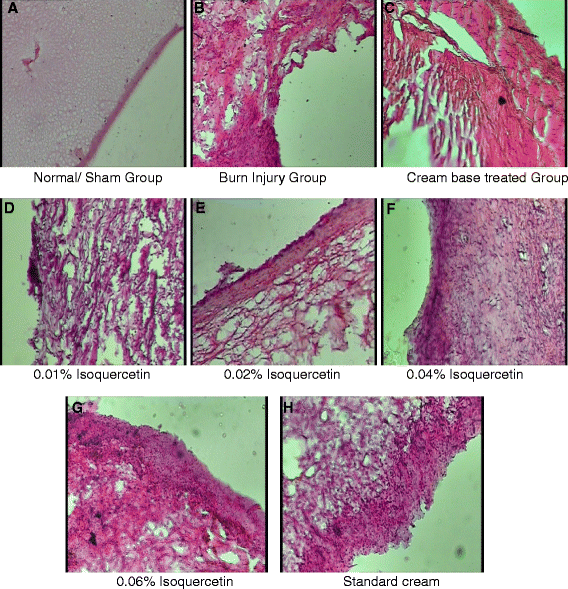Evaluation of the wound healing potential of isoquercetin-based cream on scald burn injury in rats
- PMID: 27574677
- PMCID: PMC4964293
- DOI: 10.1186/s41038-016-0032-1
Evaluation of the wound healing potential of isoquercetin-based cream on scald burn injury in rats
Abstract
Background: The present study was designed to evaluate the potential of isoquercetin-based cream formulation on scald burn wound injury in rats.
Methods: Four isoquercetin-based cream formulations viz. 0.01, 0.02, 0.04, and 0.06 % w/w were prepared. Cream base and standard anti-burn cream containing silver sulfadiazine were also used for comparison. Scald burn was given to rats by pouring water at 90 °C on a shaved dorsal area of 20 mm(2). Deep second-degree burn injury was produced which was evaluated for the next 21 days for the percentage of wound contraction and period of epithelialization. On day 21, the rats were sacrificed and histopathological slides were prepared using hematoxylin-eosin staining. Burned tissue was also screened for levels of oxidative stress using thiobarbituric acid reactive species (TBARS) and reduced glutathione (GSH) estimation.
Results: There was a significant increase in the percentage of wound contraction and a significant decrease in the period of epithelialization in isoquercetin-based cream-treated groups as compared with the control group. However, most significant results were obtained with isoquercetin 0.06 % w/w cream. Histologically, isoquercetin 0.06 % w/w cream treatment resulted in almost complete re-epithelialization and re-structuring of the wound tissue. There was a significant rise in TBARS and a decrease in GSH levels in the burn injury group which was reversed to a major extent by the application of isoquercetin-based cream.
Conclusions: The results indicate the wound healing potential of isoquercetin-based cream. Tissue biochemical studies indicate towards a possible role of free radical scavenging in the observed effects of isoquercetin in wound healing.
Keywords: Burn; Free radicals; Isoquercetin; Scald; Wound healing.
Figures



Similar articles
-
Globularia arabica Methanolic Leaf Extract Has Higher Efficacy on Burn Wound Healing in Diabetic Rats Compared to Malva slyvestries Methanolic Leaf Extract.J Burn Care Res. 2023 May 2;44(3):563-572. doi: 10.1093/jbcr/irac089. J Burn Care Res. 2023. PMID: 35751855
-
Obstruction of the formation of granulation tissue leads to delayed wound healing after scald burn injury in mice.Burns Trauma. 2021 Apr 29;9:tkab004. doi: 10.1093/burnst/tkab004. eCollection 2021. Burns Trauma. 2021. PMID: 34212057 Free PMC article.
-
Pentadecapeptide BPC 157 cream improves burn-wound healing and attenuates burn-gastric lesions in mice.Burns. 2001 Dec;27(8):817-27. doi: 10.1016/s0305-4179(01)00055-9. Burns. 2001. PMID: 11718984
-
Effectiveness of four topical treatment methods in a rat model of superficial partial-thickness burn injury: the advantages of combining zinc-hyaluronan gel with silver foam dressing.Injury. 2022 Dec;53(12):3912-3919. doi: 10.1016/j.injury.2022.09.062. Epub 2022 Oct 2. Injury. 2022. PMID: 36216616
-
Norfloxacin and metronidazole topical formulations for effective treatment of bacterial infections and burn wounds.Interv Med Appl Sci. 2016 Jun 1;8(2):68-76. doi: 10.1556/1646.8.2016.2.4. Interv Med Appl Sci. 2016. PMID: 28386462 Free PMC article. Review.
Cited by
-
Optimized Sambucus nigra L., Epilobium hirsutum L., and Lythrum salicaria L. Extracts: Biological Effects Supporting Their Potential in Wound Care.Antioxidants (Basel). 2025 Apr 27;14(5):521. doi: 10.3390/antiox14050521. Antioxidants (Basel). 2025. PMID: 40427403 Free PMC article.
-
Bioinspired gelatin based sticky hydrogel for diverse surfaces in burn wound care.Sci Rep. 2022 Aug 12;12(1):13735. doi: 10.1038/s41598-022-17054-w. Sci Rep. 2022. PMID: 35962001 Free PMC article.
-
The therapeutic effects of Agrimonia eupatoria L.Physiol Res. 2020 Dec 31;69(Suppl 4):S555-S571. doi: 10.33549/physiolres.934641. Physiol Res. 2020. PMID: 33646008 Free PMC article. Review.
-
Anti-inflammatory effect of Adiantum capillus-veneris hydroalcoholic and aqueous extracts on acetic acid-induced colitis in rats.Avicenna J Phytomed. 2020 Sep-Oct;10(5):492-503. Avicenna J Phytomed. 2020. PMID: 32995327 Free PMC article.
-
Old Plant, New Possibilities: Wild Bilberry (Vaccinium myrtillus L., Ericaceae) in Topical Skin Preparation.Antioxidants (Basel). 2021 Mar 16;10(3):465. doi: 10.3390/antiox10030465. Antioxidants (Basel). 2021. PMID: 33809607 Free PMC article.
References
-
- Monafo W, Bessy P. Wound care in total burn care. In: Herndon D, editor. Total burn care. Philadelphia, PA: WB Saunders; 2001. p. 109.
-
- Williams W. Pathophysiology of the burn wound. In: Herndon D, editor. Total burn care. Philadelphia, PA: WB Saunders; 2001. p. 514.
-
- Singh V, Devgan L, Bhat S, Milner SM. The pathogenesis of burn wound conversion. Ann PlastSurg. 2007;59:109–115. - PubMed
LinkOut - more resources
Full Text Sources
Other Literature Sources

